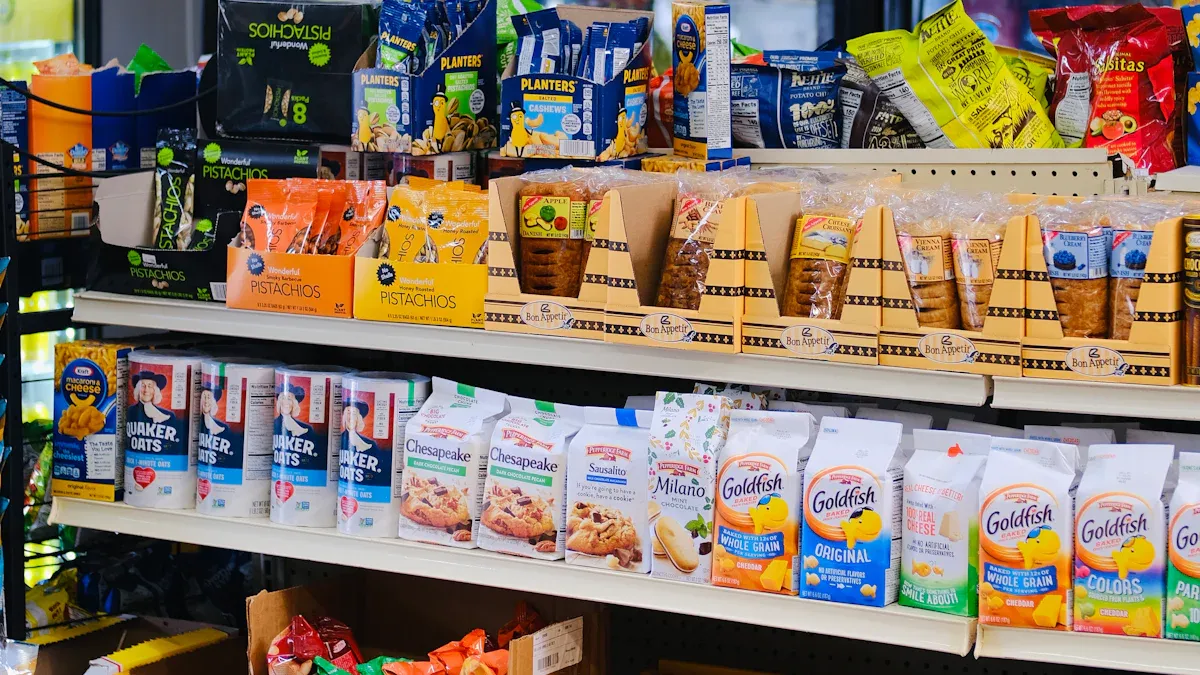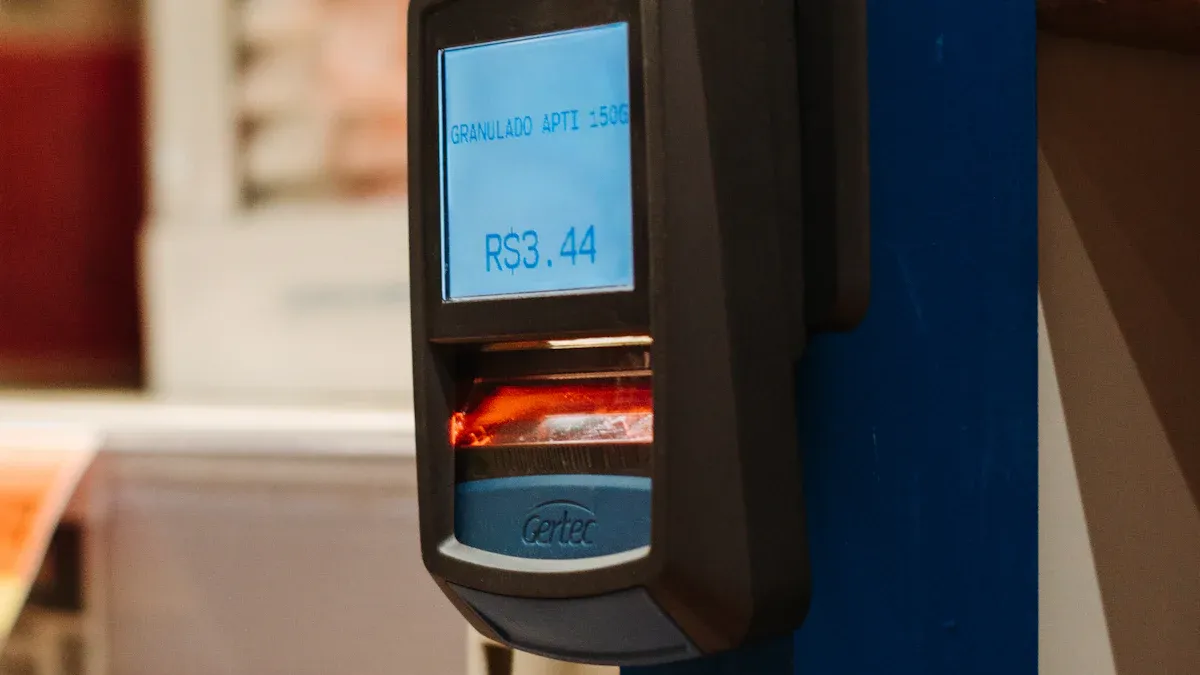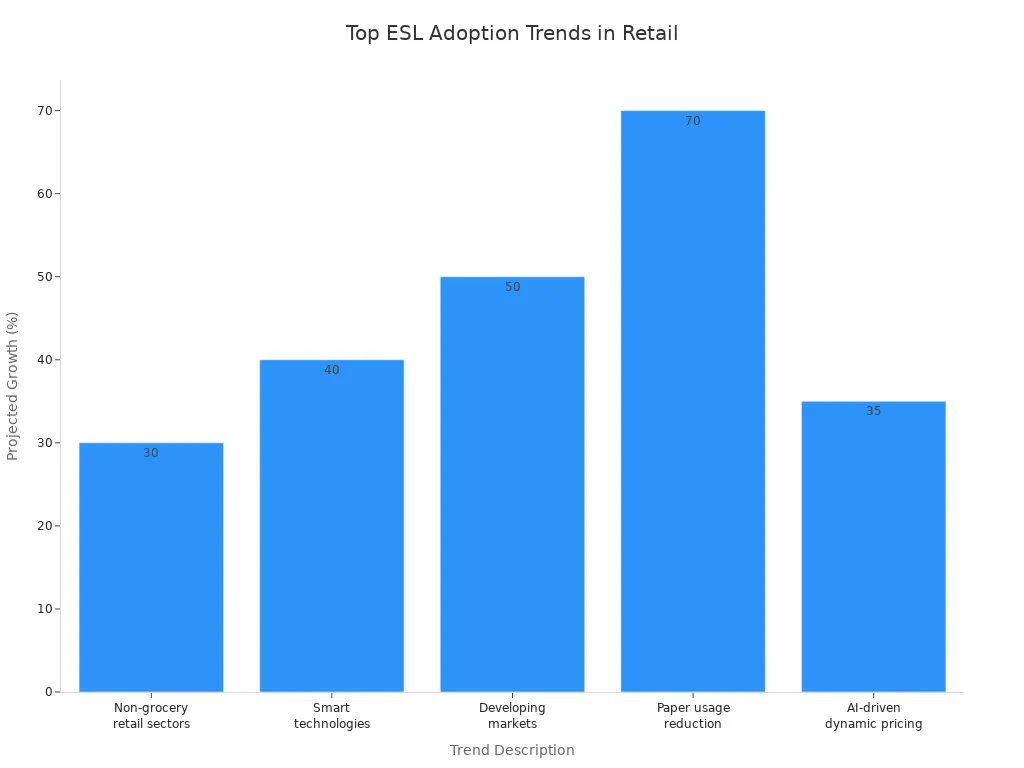
You see rapid changes in retail pricing. Nearly 69% of global retailers now use electronic shelf labels for real-time pricing. You gain clear advantages when you choose digital shelf labels, such as the ability to streamline pricing updates, improve operational efficiency, and support dynamic pricing strategies. By using solutions like ESL Gateway AP and ESL Price Tag, you reduce labor costs and enable quick price adjustments. Esl Retail environments benefit from digital accuracy and reliability, helping you stay competitive.
Electronic Shelf Label Adoption: Key Drivers
Efficiency and Labor Savings
You face constant pressure to optimize store operations and reduce unnecessary expenses. Digital shelf labels offer a direct solution by automating the price update process. Instead of spending hours manually replacing paper tags, you can update thousands of prices across your store in minutes. This shift not only saves time but also reduces the risk of human error.
Consider the following comparison:
| Method | Labor Hours per Week | Annual Labor Cost |
|---|---|---|
| Traditional Labeling | 10 | $10,000 |
| Electronic Shelf Labels | Significantly Reduced | Up to 80% Savings |
With digital shelf labels, you can make 1,400 price changes in under 10 minutes—a task that would take four days using traditional methods. This efficiency allows your staff to focus on customer service and sales, rather than repetitive labeling tasks. You also eliminate the need for paper and printing supplies, further reducing operational costs.
Tip: By automating price updates, you can reallocate labor to higher-value activities, boosting both productivity and morale.
Real-Time Pricing and Dynamic Updates
Digital shelf labels empower you to respond instantly to market changes. You can adjust prices in real time, whether you need to match a competitor’s promotion, clear out inventory, or react to supply chain shifts. This agility is especially valuable in today’s fast-paced retail and e-commerce environment.
- You can update thousands of digital shelf labels simultaneously from a central system.
- Price changes occur instantly, ensuring consistency across all locations.
- You reduce errors and maintain accurate pricing, which builds customer trust.
The measurable benefits of real-time pricing include:
| Benefit | Measurement/Statistic |
|---|---|
| Pricing Accuracy | 30% reduction in pricing errors |
| Labor Cost Reduction | Up to 80% reduction in labor costs |
| Revenue Increase | Higher price change frequency correlates with increased revenue |
| Product Waste Reduction | Reduced from 20-30% to nearly zero |
| Customer Trust | 25% decrease in product return rates at Walmart |
| Improved Staff Productivity | Employees focus on customer service instead of updating prices |
You gain the flexibility to implement dynamic pricing strategies, such as adjusting prices based on stock levels or sales velocity. This capability helps you maximize revenue and minimize waste, especially for products with a short shelf life.
Competitive Advantage in Retail
The retail market is more competitive than ever. Digital shelf labels give you a distinct edge by enabling automation and real-time data integration. You can respond quickly to market trends, consumer demand, and competitor actions. This responsiveness helps you maintain profitability and adapt to changing conditions.
The integration of smart technologies, such as IoT and AI, with electronic shelf labels provides you with valuable insights. You can analyze sales data, monitor inventory, and make informed decisions that drive growth. Automation also frees up resources, allowing you to invest in customer experience and innovation.
- The market for electronic shelf labels continues to grow as more retailers seek automation and real-time pricing.
- Digital shelf labels support transparency and accuracy, which are increasingly important to consumers.
- Retailers who adopt these solutions often see improved gross margins and operational efficiency.
Note: By embracing digital shelf labels, you position your business for long-term success in a rapidly evolving market.
Benefits of Digital Shelf Labels for Retailers

Improved Price Accuracy
You face constant challenges with price accuracy in your stores. Manual updates with paper tags often lead to errors, which can frustrate customers and result in regulatory fines. Digital shelf labels solve this problem by providing instant, centralized price updates. You can ensure that every shelf displays the correct price at all times.
Consider the following comparison:
| Aspect | Digital Price Tags (ESLs) | Paper Price Tags |
|---|---|---|
| Pricing Error Rate | Lower, errors are manageable and measurable | Higher, due to manual processes |
| Typical Error Rate in Retail Environments | N/A | 5% to 10% |
With digital shelf labels, you reduce the risk of pricing discrepancies. This accuracy helps you comply with pricing regulations and avoid costly penalties. The technology supports instant, error-free price updates, which is essential for meeting consumer protection laws.
| Benefit Category | Description | Example / Impact |
|---|---|---|
| Compliance with Pricing Rules | Instant, error-free price updates help meet regulatory requirements and avoid fines. | Supports consumer protection laws and pricing regulations compliance. |
Note: Accurate pricing not only protects your business from fines but also builds trust with your customers.
Enhanced Customer Experience
You want your customers to enjoy a seamless shopping experience. Digital shelf labels help you achieve this goal by providing real-time pricing accuracy and detailed product information. Customers see the correct price every time, which reduces frustration at checkout and increases confidence in your store.
| ESL Features | Impact on Customer Well-Being | Effect on Customer Satisfaction |
|---|---|---|
| Improved Product Information (EPI) | Enhances subjective well-being | Increases customer satisfaction |
| Customer Attraction (CA) | Boosts psychological well-being | Promotes customer loyalty |
| Unmanned Shopping Experience (USE) | Improves overall shopping experience | Leads to positive post-purchase behavior |
You can display nutritional facts, promotions, and even QR codes for more information. This transparency helps shoppers make informed decisions and strengthens the relationship between you and your customers.
| Benefit | Description |
|---|---|
| Real-time pricing accuracy | ESLs ensure that customers see the correct prices, reducing frustration at checkout. |
| Enhanced product information | Customers can access detailed product descriptions, nutritional info, and promotions. |
| Interactive features | ESLs can include QR codes for additional information and allow for mobile payments. |
- Customers find products easily due to clear labeling.
- Staff spend more time assisting shoppers.
- ESLs can display icons for health-related product categories.
Tip: When you provide accurate information and clear pricing, you increase customer satisfaction and encourage positive word of mouth.
Streamlined Operations
You need efficient operations to stay competitive in the retail and e-commerce market. Digital shelf labels streamline key processes, allowing you to manage pricing and inventory with ease. You can update prices across all stores in seconds, minimizing manual labor and reducing the risk of errors.
| Process | Description |
|---|---|
| Pricing Management | ESLs simplify the task of pricing management, allowing for quick updates and reducing errors. |
| Inventory Updates | Retailers can efficiently update inventory information across all stores, minimizing manual labor. |
| Customer Engagement | ESLs enhance customer engagement by displaying key product information and promotional content. |
You benefit from rapid price adjustments and the ability to facilitate markdowns for near-expiry items. Digital shelf labels also help you minimize pricing discrepancies across different platforms, which is crucial for maintaining consistency in a multi-channel environment.
- Rapid price adjustments
- Facilitation of markdowns for near-expiry items
- Minimization of pricing discrepancies across different platforms
You also see significant time and cost savings. For example, the annual labor cost for price changes drops to around $3,906, and you spend about 13,000 minutes (217 hours) per year on these tasks. The average payback period for an electronic shelf label system is 12 to 18 months, making the return on investment (ROI) clear and measurable.
| Cost/Benefit Category | Estimated Amount (Annual) |
|---|---|
| Annual Labor Cost for Price Changes | ~$3,906 |
| Annual Time Spent | 13,000 minutes (~217 hours) |
| ESL System Annual Maintenance | ~$2,000 |
| Payback Period | 12 to 18 months (on average) |
Callout: Streamlined operations free up your staff to focus on customer service and sales, supporting your store’s growth and long-term success.
Electronic Shelf Labels Market Landscape
Growth Statistics and Market Size
You see the global digital shelf label market expanding rapidly. Current projections estimate the global esl market will reach between USD 1.97 billion and USD 2.6 billion by 2025. Analysts expect a strong growth rate, with forecasts showing a compound annual growth rate (CAGR) of 12.8% from 2024 to 2033. Some sources predict an even higher CAGR of 13.9% from 2025 to 2030. This surge reflects the increasing demand for digital solutions in retail environments.
- The global digital shelf label market is projected at USD 2.6 billion in 2025.
- Some reports show a market size of USD 1.97 billion in 2025.
- Growth rates range from 12.8% to 13.9% CAGR over the next five to ten years.
You notice that Asia Pacific leads in adoption, especially in Japan, India, and South Korea. Latin America also shows strong momentum, with Brazil modernizing its retail sector. The Latin American market is expected to grow from USD 75.9 million in 2018 to USD 452.3 million by 2032, at a CAGR of 16.3%.
Adoption Trends and Leading Retailers
Retailers worldwide adopt electronic shelf label technology to stay ahead. You see several trends shaping the market:
| Trend Description | Projected Growth |
|---|---|
| ESL adoption in non-grocery retail sectors | 30% by 2024 |
| Integration of ESLs with smart technologies | 40% by 2025 |
| ESL adoption in developing markets | 50% by 2026 |
| Reduction in paper usage due to ESLs | 70% by 2025 |
| Use of AI-driven dynamic pricing with ESLs | 35% by 2027 |

The primary motivation for deploying electronic shelf labels is to maintain a competitive edge in delivering benefits to our customers. The way the system works is that it ensures labels consistently display accurate prices for the relevant items so our customers know they won’t face a discrepancy at the till point.
Case Studies of Electronic Shelf Label Implementation
You can learn from real-world examples. Retailers report several benefits after implementing digital shelf labels:
- Real-time price updates improve operational efficiency.
- Enhanced customer experience builds trust and loyalty.
- Scalable solutions support large retail networks.
However, you may face challenges such as complex supply chains, the need for effective communication across different ESL types, and the transition from on-premise to cloud-based systems.
| KPI | Impact |
|---|---|
| Labor cost reduction | 30-50% decrease in manual pricing tasks |
| Pricing accuracy | Up to 40% fewer errors |
| Sales performance | 10-15% increase during promotions |
| Customer satisfaction | Improved trust and fewer checkout disputes |
| Sustainability | Reduced paper and energy consumption |
Challenges of Electronic Shelf Labels in Retail
Implementation Costs and ROI Considerations
You face significant upfront costs when you deploy electronic shelf label systems. The price per label ranges from $5 to $20, depending on whether you choose basic monochrome or full-color advanced options. Installation fees can add $300 to $3,000 or more, especially for large stores. Maintenance and software licensing also contribute to your total investment.
| Type of ESL | Cost per Label | Additional Costs |
|---|---|---|
| Basic Monochrome | $5 – $8 | Installation: $300 – $2,000+ |
| Full-Color Advanced | $15 – $20 | Software Licensing: Varies |
| Installation | N/A | $300 – $3,000+ |
| Maintenance | N/A | Replacement/Upgrades: Varies |
Although the initial investment is high, you often see a strong return on investment over time. Many retailers report achieving ROI within 24 to 36 months, and some reach this milestone in as little as 12 months when they use price optimization software. You save on labor and material costs, eliminate paper expenses, and reduce errors with real-time updates.
You benefit from labor cost reduction, improved price accuracy, and dynamic pricing opportunities. These factors drive long-term savings and boost your overall ROI.
Integration with Existing Retail Systems
You may encounter challenges when you connect digital shelf labels to your current retail management systems. Legacy system compatibility often creates obstacles, especially if your point-of-sale or inventory software does not support modern integration methods. Data synchronization is another hurdle, as you must ensure that price updates appear across all platforms, including e-commerce channels.
- Legacy system compatibility requires middleware or custom adapters.
- Data synchronization demands a centralized price management system.
- Network infrastructure must support reliable wireless communication.
| Best Practice | Description |
|---|---|
| Update prices chain-wide in seconds | Ensures all products reflect the correct price. |
| Run promotions without delays | Allows for immediate implementation of discounts. |
| Prevent losses due to incorrect tagging | Reduces errors in pricing and inventory control. |
You should integrate ESLs with ERP and POS systems to keep stock levels and pricing data synchronized. This approach supports dynamic pricing and real-time updates, helping you maintain consistency across all channels.
Vendor Transparency and Reliability
You need to evaluate vendor transparency and reliability before selecting a provider. Open access to real-time data builds trust and improves communication with suppliers. Clear performance expectations help you align delivery times and pricing accuracy with your business goals. Collaborative improvement initiatives foster strong partnerships and allow for honest discussions about performance metrics.
| Key Aspect | Description |
|---|---|
| Open Access to Real-Time Data | Suppliers see sales trends and inventory levels, improving operational efficiency. |
| Clear Performance Expectations | Measurable standards ensure accountability and consistency. |
| Collaborative Improvement Initiatives | Honest discussions lead to cost reductions and better service. |
You should also assess installation and maintenance requirements, user interface usability, and compatibility with existing systems. Define your business objectives and financial considerations to ensure the solution aligns with your long-term strategy.
Addressing Misinformation and Building Customer Trust
You face a growing challenge as misinformation about electronic shelf labels spreads among customers. Many shoppers may misunderstand how ESLs work or question their reliability. You need to address these concerns directly to maintain trust and support your brand’s reputation.
You can use several effective strategies to combat misinformation and foster transparency:
- Prioritize accurate communication about ESL capabilities. Always provide clear, factual information about what your digital shelf labels can and cannot do.
- Promote transparency in your messaging. Explain how ESLs work and why you use them, both in-store and through your digital channels.
- Engage openly with customers through customer service and social media. Respond to questions and correct misconceptions quickly.
- Set realistic expectations regarding ESL battery life and operational requirements. Avoid overstating features or making promises you cannot keep.
- Encourage independent verification of claims. Invite customers to learn more from reputable sources or industry partners.
- Foster proactive consumer education. Offer in-store demonstrations or educational materials that explain the benefits and limitations of ESLs.
- Leverage technology to monitor for misinformation. Use digital tools to track conversations and address rumors before they spread.
Transparency should be at the heart of any dynamic pricing strategy. You need to openly share why prices are changing and how this benefits customers.
Consistency in your messaging builds a strong brand. When you use intelligent displays, you ensure every customer sees accurate and timely information. This approach reinforces your commitment to quality and reliability.
| Trust-Building Action | Customer Impact |
|---|---|
| Consistent, accurate pricing | Increases confidence in your store |
| Real-time updates | Shows commitment to fairness and responsiveness |
| Open communication | Builds long-term loyalty and positive relationships |
You empower your customers by providing real-time, competitive deals. This flexibility aligns with their expectations for fairness and value. When you address misinformation and communicate openly, you strengthen trust and create lasting customer relationships.
Practical Steps for Adopting Electronic Shelf Labels

Assessing Store Needs and Objectives
You should begin by evaluating your store’s unique requirements before implementing digital shelf labels. Consider how these systems will impact your daily operations, customer experience, and long-term strategy. The following table outlines key factors you need to review:
| Factor | Description |
|---|---|
| Real-time price updates | ESLs enable immediate adjustments based on market conditions, enhancing pricing strategies. |
| Reduction of paper waste | ESLs align with sustainability goals, appealing to environmentally conscious consumers. |
| Improved inventory management | ESLs facilitate better tracking and management of stock levels, reducing overstocking or stockouts. |
| Enhanced operational efficiency | Automating pricing reduces manual labor, allowing staff to focus on critical tasks. |
| Clear information for customers | ESLs provide accurate and up-to-date product details, enhancing customer trust and satisfaction. |
| High installation costs | Significant upfront investment required, which may deter small and medium-sized retailers. |
| Supporting infrastructure expenditure | Necessary infrastructure increases overall costs, impacting the cost-benefit ratio for retailers. |
Tip: Align your objectives with your store’s size, customer base, and sustainability goals to maximize the benefits of digital shelf labels.
Choosing the Right Digital Shelf Labels Solution
When you select a digital shelf label solution, focus on features that support your store’s current and future needs. Look for options that offer:
- In-store optimization for efficient workflows
- Scalability to support future growth
- Future-proof technology that adapts to new trends
- Compatibility with your existing systems
- A clear understanding of total cost of ownership
- Compliance with industry standards
- Security to protect sensitive data
- A variety of label sizes and color features
- Different ESL variations to suit product types
- Long battery life for reduced maintenance
You should compare solutions carefully to ensure they fit your operational requirements and budget.
Staff Training and Change Management
You need to prepare your team for the transition to digital shelf labels. Provide hands-on training so staff can operate the new system confidently. Explain how digital technology will change daily routines and highlight the benefits, such as reduced manual tasks and improved accuracy. Encourage open communication to address concerns and gather feedback. A well-managed change process helps your staff adapt quickly and supports a smooth rollout.
Note: Ongoing support and refresher training sessions keep your team updated as your digital system evolves.
You gain a clear advantage when you adopt electronic shelf labels for real-time pricing. ESLs help you improve price accuracy, streamline operations, and enhance customer trust.
- You reduce labor costs and boost efficiency.
- You position your store for future growth with dynamic pricing.
As technology evolves, you can expect digital shelf labels to become even more essential for staying competitive in retail.
FAQ
What is an electronic shelf label (ESL)?
An electronic shelf label is a digital display system that shows product prices and information on store shelves. You can update prices remotely and instantly, which helps you maintain accuracy and save time.
How long do ESL batteries typically last?
Most ESL batteries last between 5 and 7 years. You do not need to replace them often. Battery life depends on how frequently you update prices and the type of display you use.
Can you integrate ESLs with your current POS system?
Yes, you can integrate most ESL solutions with your existing POS system. You may need middleware or software updates. Integration ensures that price changes appear instantly on both the shelf and at checkout.
Are electronic shelf labels secure?
You benefit from strong security features in modern ESL systems. These include encrypted wireless communication and user authentication. Always choose a reputable vendor to ensure your data and pricing remain protected.


